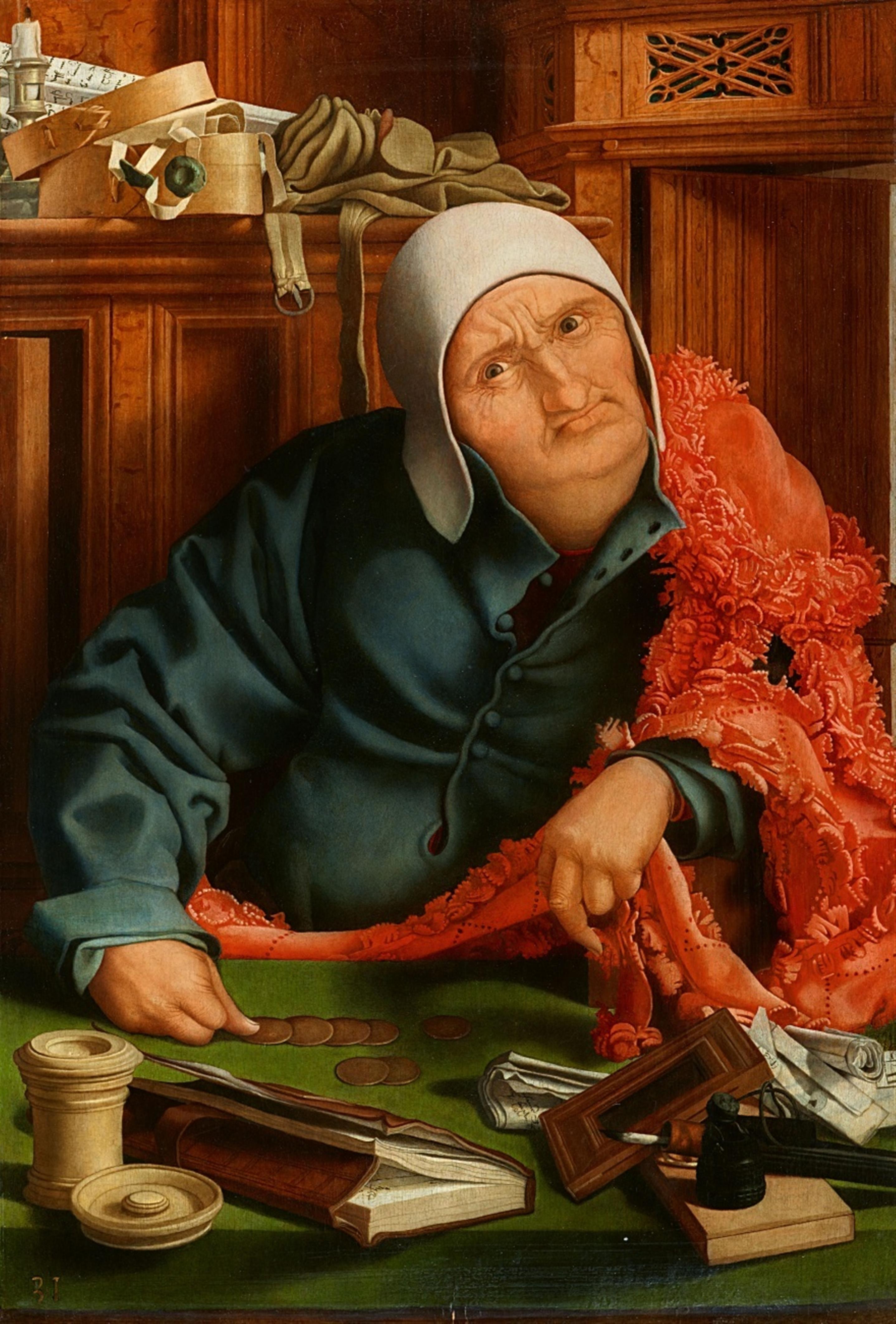Marinus van Reymerswale
The money-lender
Oil on panel. 80.5 x 54.5 cm.
Marinus van Reymerswale was an enigmatic artist in more ways than one. Securely attributed works of his hand are just as scarce as biographical details of his life. We know only that he was born around 1490 in Reimerswaal in the province of Zeeland; in 1504 he was enrolled as a "poor student" at the University of Leuven and in 1509 he stayed in Antwerp with Quinten Massys. Marinus is then documented as a painter and cartographer in Reimerswaal, his birthplace, in 1531 and later around 1540 he moved to Goes, where he died in 1556 at the latest.
In 1604, Karel van Mander wrote in his schilder-boeck that many works by Reymerswale were to be seen in Zeeland and mentioned one with the title A Customs Officer in his Office. Works such as these are still considered the main domain of the painter to this day. For apart from his famous Saint Jerome in His Study, two small panels with depictions of the Virgin, and The Calling of Saint Matthew, Reymerswale only ever painted interior scenes showing customs officers, tax collectors and money changers conducting their dubious business.
Van Reymerswale became acquainted with the genre, the so called Kontorbild, during his time with Quinten Massys. However, the persistence and exclusivity with which he pursued this particular subject and the grotesque bitterness with which he imbued his protagonists speak of an entirely different language to that of his predecessor. Marinus mocks "the greed and stinginess, the bureaucratic stubbornness and the harsh relentlessness of counting and weighing money" (Friedländer, op. cit.). In doing so, he distances himself from the classical genre painting, which is concerned with the real-life activities of contemporary people. The figures he depicts, on the other hand, wear strangely old-fashioned costumes and bizarre headgear that appear almost timeless - probably with the aim of unmasking the true nature of the hated professions of usurers and tax collectors. The grotesque forms of his figures' faces and their grimacing features also characterize his protagonists as malicious and deceitful. Van Reymerswale was an angry painter. Or was he just trying to warn us?
Although Antwerp can be regarded as Marinus van Reymerswale's spiritual home, his seclusion in the confines of the Dutch provinces appears to have benefited the originality of his works. Apart from the inspiration provided by Massys, his idiosyncratic paintings can be viewed in a more general context somewhere between those of Hieronymus Bosch and Pieter Brueghel the Elder. Avarice and greed also played an important role in these painters' works. Moralizing themes such as these were already being reflected upon in the late 15th and early 16th century in literary works such as Sebastian Brant's Ship of Fools or in the popularity of paintings illustrating biblical quotations, which the Dutch painters hid and encoded, but always consciously incorporated into their works. The deadly sin of greed, or avaritia, was one expanded upon not only by artists, but also by philosophers such as Erasmus of Rotterdam and other Humanists. In art, this subject is often closely connected to the vanitas motif, which later became an independent genre. In the paintings of Marinus van Reymerswale, the idea of the futility and the transience of worldly goods is also subtly but unmistakably referred to in small, seemingly random, objects - for example, the extinguished candle or the oval wooden box full of crumpled papers.
This painter's œuvre is characterized by numerous repetitions of the same motifs. The well-known scholar of van Reymerswale's works, Agri Mackor, has attributed alone 19 versions of Saint Jerome in His Study to the artist. However, the expert has confirmed that only one version of the present composition is known to him. Mackor was able to study this painting in person in the late 1980s when it was in the possession of Newhouse art dealers in New York. In doing so, he recognised the similarity between this work and the composition of the money changer in Albrecht Dürer's woodcut The Presentation of the Virgin. The print formed part of his cycle of 19 works on the Life of the Virgin, which was first published in 1511 and reprinted several times in the following years.
The inscriptions in this work suggest that the figure depicted is a Waerdiere, an appraiser. In Marinus' time, immovable goods were valued by independent appraisers in order to determine direct taxes on them.
We would like to thank Dr Agri Mackor for kindly providing information to assist in cataloguing this lot.
Provenance
With Adam Williams / Newhouse Galleries, New York.
Literature
Peter Van der Coelen and Friso Lammertse (eds.): De ontdekking van het dagelijks leven van Bosch tot Bruegel, Rotterdam, Museum Boijmans Van Beuningen, exhib. cat. Rotterdam 2015, p.112, fig. 106;
About the artist cf. Max J. Friedländer: Die altniederländische Malerei, vol. XII, Leiden 1935, pp. 69-76.

